Human Orbital Spaceflights
![]()
International Flight No. 190STS-80Columbia (21)80th Space Shuttle missionUSA |
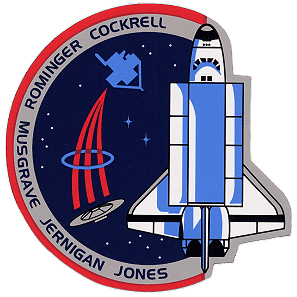 |
![]()
Launch, orbit and landing data
walkout photo |
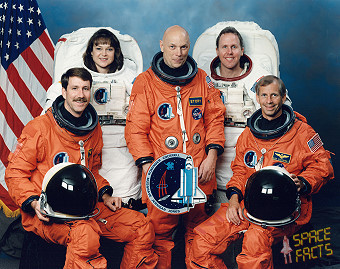 |
||||||||||||||||||||||||||||
alternative crew photo |
Crew
| No. | Surname | Given names | Position | Flight No. | Duration | Orbits | |
| 1 | Cockrell | Kenneth Dale "Taco" | CDR | 3 | 17d 15h 53m 17s | 279 | |
| 2 | Rominger | Kent Vernon | PLT | 2 | 17d 15h 53m 17s | 279 | |
| 3 | Jernigan | Tamara Elizabeth "Tammy" | MS-1, EV-1 | 4 | 17d 15h 53m 17s | 279 | |
| 4 | Jones | Thomas David | MS-2, EV-2, FE | 3 | 17d 15h 53m 17s | 279 | |
| 5 | Musgrave | Franklin Story | MS-3, IV-1 | 6 | 17d 15h 53m 17s | 279 |
Crew seating arrangement
|
 |
* stood throughout re-entry, |
||||||||||||||||||||||||
Hardware
| Orbiter : | OV-102 (21.) |
| SSME (1 / 2 / 3): | 2032 (5.) / 2026 (6.) / 2029 (14.) |
| SRB: | BI-084 / RSRM 49 |
| ET: | ET-80 (LWT-73) |
| OMS Pod: | Left Pod 05 (10.) / Right Pod 01 (25.) |
| FWD RCS Pod: | FRC 2 (21.) |
| RMS: | 202 (2.) |
| EMU: | EMU No. 3013 (PLSS No. 1013) / EMU No. 3006 (PLSS No. 1006) / EMU No. 3015 (PLSS No. 1015) |
Flight
|
Launch from Cape Canaveral (KSC) and
landing on Cape Canaveral (KSC), Runway 33. The launch date of October 31, 1996 was first threatened by change-out of STS-79 boosters with those slated to fly on STS-80 and delay of STS-79 liftoff. Hurricane preparations because of Hurricane Fran in early September 1996 halted STS-80 booster stacking operations in the Vehicle Assembly Building (VAB), prompting mission managers to reschedule launch date to November 08, 1996. At Flight Readiness Review (FRR) October 28, 1996, mission managers declined to formalize launch date pending analysis of erosion in STS-79 booster nozzles. At Delta FRR November 04, 1996, launch date changed to no earlier than November 15, 1996 to allow engineers more time to complete study of nozzle erosion. At follow-up FRR November 11, 1996 November 15, 1996 was set as official launch date, pending a commercial Atlas launch November 13, 1996, and launch countdown began. Just two days later, the launch was postponed to November 19, 1996 due to scrub of Atlas launch and predicted bad weather in KSC vicinity for period of several days, and count remained in an extended hold. Columbia's five-person crew deployed and retrieved two free-flying spacecraft. The first of the two free-flying payloads being carried aboard Columbia was the Orbiting Retrievable Far and Extreme Ultraviolet Spectrometer (ORFEUS) satellite. The ORFEUS instruments were mounted on the reusable Shuttle Pallet Satellite (SPAS) and studied the origin and makeup of stars. The second of the two free-flying payloads aboard Columbia was the Wake Shield Facility (WSF). The WSF was designed to fly free of the Shuttle, creating a super vacuum in its wake in which to grow thin film wafers for use in semiconductors and other high-tech electrical components. In addition, Tamara Jernigan and Thomas Jones were scheduled perform two six-hour spacewalks during STS-80. The Orbiting and Retrievable Far and Extreme Ultraviolet Spectrograph-Shuttle Pallet Satellite II (ORFEUS-SPAS II) mission was the third flight to use the German-built ASTRO-SPAS science satellite. The ASTRO-SPAS program was a cooperative endeavor between NASA and the German Space Agency, DARA. ORFEUS-SPAS II, a free-flying satellite, was deployed and retrieved using the Space Shuttle Columbia's Remote Manipulator System (RMS). The goal of this astrophysics mission was to investigate the rarely explored far- and extreme-ultraviolet regions of the electromagnetic spectrum, and study the very hot and very cold matter in the universe. ASTRO-SPAS was a carrier designed for launch, deployment and retrieval by the Space Shuttle. Once deployed from the Shuttle's RMS, ASTRO-SPAS operated quasi-autonomously for 14 days in the vicinity of the Shuttle. The carrier's inclination was 28.4 degrees with an altitude of 218 statute miles (350.8 km). After completion of the free flight phase, the satellite was retrieved by the RMS, returned to the Shuttle cargo bay and returned to Earth. The one-meter diameter ORFEUS-Telescope with the Far Ultraviolet (FUV) Spectrograph and the Extreme Ultraviolet (EUV) Spectrograph comprised the main payload. A secondary, but highly complementary, payload was the Interstellar Medium Absorption Profile Spectrograph (IMAPS). In addition to the astronomy payloads, ORFEUS-SPAS II carried the Surface Effects Sample Monitor (SESAM), the ATV Rendezvous Pre-Development Project (ARP), and the Student Experiment on ASTRO-SPAS (SEAS). The ORFEUS-SPAS II mission was dedicated to astronomical observations at very short wavelengths, specifically the two spectral ranges Far Ultraviolet (FUV, 90-125 nanometers) and Extreme Ultraviolet (EUV, 40-90 nanometers). This part of the electromagnetic spectrum, which is obscured by the Earth's atmosphere precluding ground-based observations and not observed by the Hubble Space Telescope, includes a high density of spectral lines (especially from various states of hydrogen and oxygen), which are emitted or absorbed by matter covering a wide range of temperatures. The ORFEUS-SPAS I mission, which flew on the Shuttle Discovery STS-51 mission in September 1993, provided valuable information in this largely unexplored region of the electromagnetic spectrum. ORFEUS-SPAS I provided information on the details of the structure and dynamics of interstellar gas clouds and insight into how molecular hydrogen is created in interstellar space. Also studied was neutral and ionized gas in the interstellar medium from the local solar neighborhood out to the distant halo of our galaxy. ORFEUS-SPAS I also obtained spectra of a very diverse group of important astrophysical objects, including a compact interacting binary star with an enormous magnetic field, three hot white dwarf stars and the distant active galaxy PKS2155-304. Star formation is not yet completely understood. Stars are, however, known to be formed in dense clouds of interstellar gas and dust. Under gravitational contraction, these clouds can become dense enough to trigger star formation. ORFEUS-SPAS II data should help to measure the size, distance, density and temperature of such clouds, which in turn aids in understanding of the circumstances under which interstellar clouds collapse and new stars are born. The core instrument was the ORFEUS telescope with the FUV Echelle spectrograph and the EUV spectrograph, built into the telescope structure. The 1-meter diameter ultraviolet telescope had a 2.4-meter focal length. An iridium coating on the primary mirror served as a reflection enhancement for ultraviolet wavelengths. Essential stability against mechanical and thermal load deformations was provided by the carbon fiber epoxy compound tube structure. The EUV spectrograph was directly exposed to light reflected off the main mirror. It covered the spectral range 40-115 nanometers, offering a resolution of about 5,000 over the whole bandwidth. In order to achieve this unprecedented high resolution over such a wide band-width, a completely new design was used, which produced high quality spectra. The FUV Echelle spectrograph was operated alternatively with the EUV spectrograph, by flipping a mirror into the beam reflected off the primary mirror. The FUV spectrograph covered the wavelength range 90-125 nanometers and provided a spectral resolution on the order of 10,000. Two reflection gratings dispersed the light into a spectrum, which was projected onto a two-dimensional micro channel-plate-detector. The detector was optimized for high spatial resolution. IMAPS, the Interstellar Medium Absorption Profile Spectrograph was a separate instrument, attached to the ASTRO-SPAS framework. IMAPS operated independently of the ORFEUS telescope. IMAPS was operated for more than two days over the duration of the free flight mission and during that time observed the brightest galactic objects at extremely high resolutions. This resolution allows study of fine structure in interstellar gas lines. The individual motions of interstellar gas clouds can be determined to an accuracy of 1.6 kilometers per second. IMAPS was successfully flown on several sounding rocket missions as well as on ORFEUS-SPAS I. Another science payload was the Surface Effects Sample Monitor (SESAM), a passive carrier for state-of-the-art optical surfaces and potential future detector materials. SESAM investigated the impact of the space environment on materials and surfaces in different phases of a Space Shuttle mission, from launch, orbit phase to re-entry into the Earth's atmosphere. Among the SESAM samples were also witness samples to the telescope mirror, allowing for accurate calibration measurements after landing. The ATV Rendezvous Pre-Development Project (ARP), part of the European Space Agency's Automated Transfer Vehicle (ATV), was an element of the European manned space transportation program. Among the objectives of the ARP were to develop and validate ground simulation facilities; develop and demonstrate on-board control software and in-orbit relative GPS capabilities; and to demonstrate the operation of the optical rendezvous sensor in orbit. The Student Experiment on ASTRO-SPAS (SEAS) was an electrolysis experiment built by students of the German high school of Ottobrunn. It consisted of eight experiment chambers containing various metal salt solutions and two electrodes. Metal 'trees' of different shapes were grown on one electrode. Photographs taken of this process during the mission were compared to those of identical experiments conducted on the ground under the full influence of Earth's gravity. On STS-80, the free-flying Wake Shield Facility (WSF-3) made its third flight into orbit. The Facility was a 12-foot (3.66 meters) diameter, free-flying stainless steel disk designed to generate an "ultra-vacuum" environment in space in which to grow semiconductor thin films for use in advanced electronics. The STS-80 astronaut crew deployed and retrieved the WSF during the 16-day mission using Columbia's "robot arm", or Remote Manipulator System. Low Earth Orbit (LEO) space has only a moderate natural vacuum, one that can be greatly improved through the generation of an "ultra-vacuum" wake behind an object moving through orbit. The WSF, as it flew, moved the residual LEO gas atoms out of the way, leaving few, if any, behind in its wake. This unique ultra-vacuum produced in the wake of the WSF has been shown in past flights to be 100 to 1,000 times better than the best operating ground-based laboratory chamber vacuums. Using this ultravacuum in space, the WSF had already grown the highest purity aluminum gallium arsenide thin films, and holds the promise of producing the next generation of semiconductor materials along with the devices they will make possible. Wake Shield has flown twice before. The first flight on STS-60, in 1994, although experiencing a hardware problem that resulted in the vehicle remaining attached to the robot arm, proved the vacuum wake concept, and realized the space epitaxy concept by growing the first-ever crystalline semiconductor thin films in the vacuum of space. The major objective of this third flight aboard STS-80 was to grow thin "epitaxial" films which could have a significant impact on the microelectronics industry because the use of advanced semiconducting thin film materials in electronic components holds a very promising economic advantage. The commercial applications for high quality semiconductor devices are most critical in the consumer technology areas of personal communications systems, fiber optic communications, high-speed transistors and processors, and opto-electronic devices. The WSF consisted of the Cross Bay Carrier and the Free Flyer. The Carrier remained in the Shuttle payload bay and had a latch system which held the Free Flyer to it. Weighing approximately 9,300 pounds (4,218 kg), (the Free Flyer itself was 4,625 pounds), the WSF occupied one quarter of the Shuttle payload bay. The Shuttle Remote Manipulator System (RMS) operated by Thomas Jones was used to remove the Free Flyer from the Carrier and deploy it for free flight in space. The WSF followed behind Columbia at a station-keeping distance of approximately 25 nautical miles (46.3 km). The Free Flyer was a fully-equipped spacecraft, with cold gas propulsion for separation from the Shuttle and a momentum bias attitude control system. Seventy- two kilowatt-hours of energy, stored in silver-zinc batteries, power the thin-film growth furnaces, substrate heaters, process controllers, and a sophisticated array of vacuum characterization devices, including mass spectrometers and total pressure gauges. The rendezvous was performed on Flight Day 7. The Wake Shield Facility was deployed using Columbia's robotic arm on Flight Day 4 by Mission Specialist Thomas Jones. After Thomas Jones locked the arm onto the WSF's grapple fixture, he released latches that held the satellite in Columbia's cargo bay and lifted it out. He then maneuvered the WSF into a position extended above and to the port side of the cargo bay with the satellite's underside facing into Columbia's direction of travel. This position, which was held for as long as two and a half hours, allowed atomic oxygen molecules scattered in low Earth orbit to "cleanse" the underside of the satellite in preparation for its free-flying experiment operations. Once the atomic oxygen exposure was completed, Thomas Jones maneuvered the satellite above and to starboard of the cargo bay, with the underside of the satellite facing away from Columbia's direction of travel, to check out WSF's Automatic Data Acquisition and Control System (ADACS). This orientation was similar to the orientation the satellite will keep while flying free from the Shuttle. After checkout of the ADACS was completed, Thomas Jones raised the WSF high above the cargo bay, with the underside facing away from the Shuttle's direction of travel, and released it. The WSF flew free from Columbia for three days, and during that time, the ORFEUS-SPAS also was flying free from Columbia. At the time the WSF was released, Columbia was about 50 nautical miles (92.6 km) ahead of ORFEUS-SPAS. WSF fired thrusters to begin a slow separation, with the WSF trailing Columbia along with ORFEUS-SPAS. The WSF reached a maximum distance of approximately 20 nautical miles (37 km) from Columbia and no less than 25 nautical miles (46.3 km) from ORFEUS-SPAS during its free-flight. While the WSF and ORFEUS-SPAS were both in free-flight, Columbia performed two small engine firings per day to maintain the proper distance from the satellites. The WSF also fired a thruster daily to maintain its position. Once the WSF was retrieved on Flight Day 7, Columbia maintained a distance of about 25 nautical miles (46.3 km) from ORFEUS-SPAS until it was retrieved on Flight Day 14. WSF had created seven films. Two planned EVA's by Thomas Jones and Tamara Jernigan, the first on November 28, 1996, were cancelled, because the airlock hatch couldn't be opened. The spacewalks should be the fifth in a continuing series of Extravehicular Activities (EVAs) called the EVA Development Flight Tests (EDFT). This flight test series of spacewalks was designed to evaluate equipment and procedures planned for the station and to build spacewalking experience in preparation for assembly of the station. On the first spacewalk, an end-to-end demonstration of a maintenance task simulating the changing out of an International Space Station battery was planned. A crane designed for use in moving large Orbital Replacement Units (ORUs) on the space station should be evaluated as part of the task. ORUs can be any piece of equipment that may be replaced on the station's exterior, and, for this evaluation, the simulated station battery should be moved using the crane. The second spacewalk was planned to evaluate working with the simulated battery from a mobile platform designed for the end of the International Space Station's robotic arm. Both spacewalkers should evaluate working with the simulated battery from the platform, which should be attached to the end of Columbia's robotic arm. The astronauts also were scheduled to evaluate a variety of other work aids and tools designed for use during station operations, including a Body Restraint Tether (BRT), a type of "third hand" stabilizing bar for spacewalkers; a Multi-Use Tether (MUT), a type of stabilizing tether similar to the BRT that can be anchored to either round U.S. handrails or square Russian handrails; and a power tool designed for the station. Another inclusion was a Space Experiment Module (SEM). The SEM included student research projects selected to fly into space. This was the first flight of the program. Among the experiments conducted were analysis of bacteria growth on food in orbit, crystal growth in space, and microgravity's effect on a pendulum. NIH-R4 was an experiment conducted for the National Institute of Health and Oregon Health Sciences University. It was designed to test the effects of spaceflight on circulation and vascular constriction. Biological Research in Canister (BRIC) explored gravity's effects on tobacco and tomato seedlings. Visualization in an Experimental Water Capillary Pumped Loop (VIEW-CPL) was conducted to test a new idea in thermal spacecraft management. The Commercial MDA ITA Experiment were a variety of experiments submitted by high school and middle school students sponsored by Information Technology Associates. Several secondary experiments were carried out by the Columbia. It was the longest Shuttle mission to date. Story Musgrave set a new record for being the oldest man in space. This record has since been surpassed. The landing originally was scheduled for December 05, 1996, but Columbia waved off two days in a row due to weather conditions in Florida. |
EVA data
| Name | Start | End | Duration | Mission | Airlock | Suit | |
| IVA | Jernigan, Tamara | 29.11.1996, 02:?? UTC | 29.11.1996, 03:?? UTC | 1h 52m | STS-80 | Columbia | EMU No. 3013 |
| IVA | Jones, Thomas | 29.11.1996, 02:?? UTC | 29.11.1996, 03:?? UTC | 1h 52m | STS-80 | Columbia | EMU No. 3006 |
Photos / Graphics
 |
 |
 |
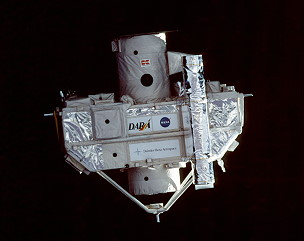 |
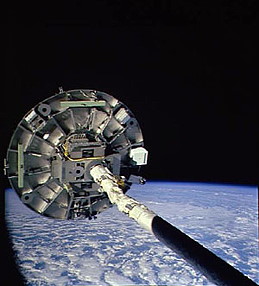 |
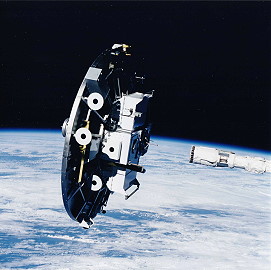 |
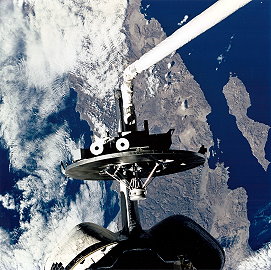 |
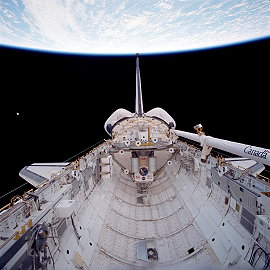 |
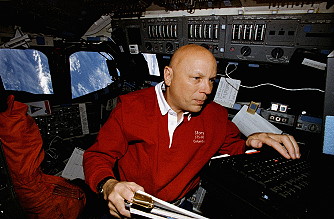 |
 |
 |
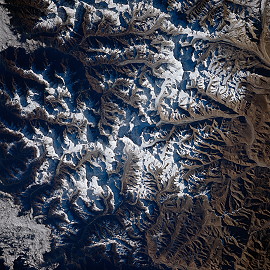 |
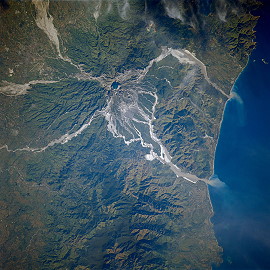 |
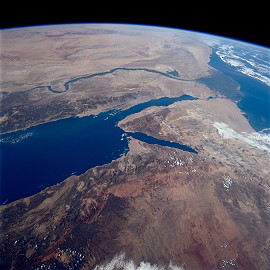 |
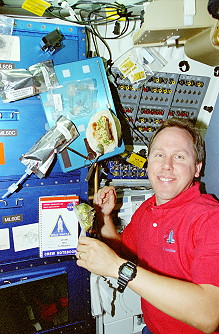 |
 |
 |
 |
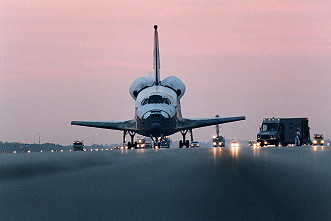 |
| © |  |
Last update on March 27, 2020.  |
 |